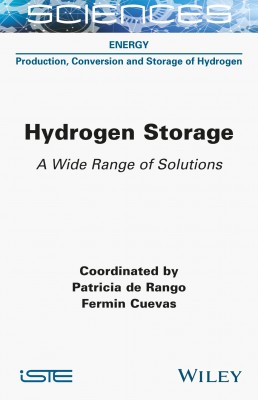
Hydrogen storage plays a central role in the hydrogen energy value chain. Efficient, economical and safe methods are essential to increase the gas’ volume density and enable the sector’s deployment.
Hydrogen Storage analyzes the various ways of storing hydrogen, whether in a gaseous state in pressurized reservoirs or geological structures, in a liquid state through the formation of ammonia or hydrogen-carrying organic liquids, or in a solid state in hydrogen-containing inorganic compounds such as metal hydrides and regenerable hydrides, or by adsorption into porous materials.
For each method, concepts are presented according to the processes used or the storage materials involved. Their advantages and disadvantages, as well as the main obstacles and challenges to be overcome, are analyzed.
This book provides an overview of the various storage solutions currently available, helping operators to choose the most appropriate method for a given application.
1. Hyperbaric Storage, David Chapelle, Damien Halm and Stéphane Villalonga.
2. Geological Storage, Laurent Truche and Frédéric-Victor Donzé.
3. Liquid Storage: LOHC, Xiaolong Ji, Valérie Meille and Catherine Pinel.
4. Liquid Storage: Ammonia, Nicolas Bion, Fabien Can, Charlotte Croisé, Xavier Courtois and Mohamed El Amine Kribéche.
5. Reversible Hydrogen Storage: Intermetallic Compounds and Mg-based Materials, Ghofrane Fedlouk, Hugo Benet, Valérie Paul-Boncour, Judith Monnier and Junxian Zhang.
6. High-Entropy Alloys for Hydrogen Storage, Nayely Pineda Romero, Claudia Zlotea, Kylia Marcus.
7. Regenerable Hydrides, Carlos A. Castilla-Martinez, Jean-Louis Bobet and Umit B. Demirci.
8. Hydrogen Adsorption in High-Surface Area Porous Materials, Rafael Morales-Ospino, Alain Celzard and Vanessa Fierro.
Patricia de Rango is CNRS Researcher at the Institut Néel, France, and co-head of the storage axis of the CNRS hydrogen research federation, FRH2. Her research includes materials for energy, particularly the study of metal hydrides for hydrogen storage. Since October 2024, she has been Coordinator of the PEPR-H2 SOLHYD project.
Fermin Cuevas is CNRS Researcher at ICMPE, France, and co-head of the storage axis of the CNRS hydrogen research federation, FRH2. His research includes intermetallic materials, composites and complex hydrides for solid hydrogen storage. Since November 2024, he has been Director of the CNRS Office in China.